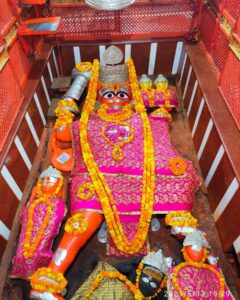Introduction
According to Hinduism, Salvation is the state that frees you from the cycle of birth and rebirth. People also call this Moksha (In Hinduism) or Nirwan (In Buddhism). It is the ultimate goal of mankind; in fact, every living being but humans is most capable of achieving it.
So, in their caliber, men try to attain the state of ‘Moksha’ through Meditation, Good Acts, or ‘Bhakti’. However, only a few succeed in this and attain ‘Moksha’ while the rest struggle to find it till the last time of their life. But, Triveni Sangam Prayagraj is the place in India that can open the door of Salvation for you when you participate in the Mahakumbh celebration, occurring every 144 years. Learn in this article, about Triveni Sangam Prayagraj, and its significance, and understand how it can liberate you from the earthly cycle of birth and rebirth.
Where Is Triveni Sangam Prayagraj ?
Triveni Sangam Prayagraj is located in Prayag, the Prayagraj city of Uttar Pradesh (India). This city is situated on the verge of three rivers—Ganga, Yamuna, and Saraswati. While Ganga and Yamuna are clearly visible, the Saraswati River is considered mystic as it can not be seen physically. Some ancient books, texts, and Vedas give proof of its existence.
The interesting fact is that the three rivers originate from different sources but converge here in Prayag; hence, the place is called Triveni Sangam (Where the Three Rivers Meet).
Understanding The Etymology Of Triveni Sangam Prayagraj
‘Prayag’ is a Sanskrit origin word that refers to ‘The Meeting Point‘. This is the point or place where the three rivers Ganga, Yamuna, and Saraswati conflux with each other. This is the reason why the city is named ‘Prayagraj’. The other term ‘Triveni’ refers to the ‘flow of three rivers’; as the thrice meet at ‘Prayag’, the place derives its name as ‘Triveni Sangam Prayagraj’.
What Is The Cultural Significance Of Triveni Sangam Prayagraj?
Triveni Sangam Prayagraj is a sacred place for Hindus. It is awarded with the tag ‘King Of All Pilgrimage’ or ‘Tirth Raj’ because – at this place, Lord Brahma performed the first ‘Yagya’, the ‘Amrit Drop’ from the ‘Amrit Kalash’ (A Pot containing liquids drinking which can lead to Immortality) felt off, and the three rivers meet here.
In Hinduism, the place where the water of three rivers meets is said to be ‘Yagyavedi’, providing the ultimate result in one’s spiritual journey when a bath is taken.
Hence, the devotees wish to come once in their lifetime to take a dip in the holy water of Sangam. They consider themselves fortunate if they get to dip or bathe in the sacred water of ‘Sangam’ as the river water is believed to have the same characteristics as of Amrit.
How Bathing In Prayag During Kumbh Opens The Door Of ‘Moksha’?
Bathing in Prayag time always gives a blissful result but bathing in Prayag during Kumbh has a special importance. Kumbh is the world’s largest religious congregation on Earth when people in crores attend the Kumbh Mela to experience the divinity on the Earth. It is believed that bathing in Prayag during Kumbh can liberate you from all your past sins. It cleanses your soul, makes you spiritual, liberates your inner, and provides you ‘Moksha’. However, If you do not know much more about Kumbh, read everything about Kumbh in our previous article.
Must Visit Ancient Places In Prayag That Can Fuel Your Spiritual Journey
Saraswati Koop
‘Koop’ is a Sanskrit origin word for ‘Well’. Named after Goddess Saraswati (the Hindu goddess of knowledge), the ‘Saraswati Koop’ reflects its association with the mystic ‘Saraswati River’ (The invisible river on Earth). It is believed that the Invisible Saraswati River flows inside of the ‘Saraswati Koop’. So, when coming to Prayag, visit the ‘Saraswati Koop’ inside Patalpuri Temple, and worship goddess Saraswati to seek her blessing.

Akshayavat Tree Temple
Akshayavat Tree is a sacred Banyan tree in Prayag on the campus of Patalpuri Temple inside Prayagraj Fort in Prayagraj city. The tree is aged more than 5000 years thus traveled through times. According to the Hindu tales, the tree witnessed all four Yuga – Satyug, Dwaparyug, Tretayug, and Kalyug. Therefore the Akshayavat tree is revered as Eternal Tree, Undying Tree, and Immortal Tree.
However, despite having its historical significance, Muslim Invaders like the Mughals tried to harm the tree. Intending to abolish its existence, they burnt it, and tried to cut it, but failed in doing so.
In recent times, the Narendra Modi government has focused on developing this pilgrimage site and the work is going to build a corridor. The corridor will be named ‘Akshayawat Corridor’ and will provide easy access to the tree. Through this corridor, the devotees can reach the ‘Akshayavat Tree’ and take the divines’ blessing.
Shri Lete Hanuman Ji Temple
Shri Lete Hanuman Ji Temple is located inside the Prayagraj Fort, where the idol of Lord Hanuman is in a sleeping posture. The historic temple is the only of its type in the world where Lord Hanuman is worshipped in a sleeping position. In this posture, the head of Lord Hanuman Ji is in the North while the Leg is in the South.
Hence, it is also a rare thing, because, in Hindu Lifestyle, Hindus are restricted to facing their leg towards the South. This is because, the South direction is considered to be the direction of ‘Yamraj’ (The Lord Of Death), and facing your leg to him can make him angry. Doing so can invite bad fortune to their life leading to loss of life or any other mishappening. Therefore every Hindu takes care of this lesson and prevents facing their leg toward the South while sleeping.

What Is The Best Time To Visit Triveni Sangam Prayagraj?
Prayagraj is the holy pilgrimage site for Hindus and is considered the ‘King Of All Pilgrimage’ means ‘Tirth Raj’. Therefore, Hindus and believers worldwide come to Prayagraj round the year to perform many rituals such as Mundan, Shradh, Holy Bath, etc.
You can see the crowd of devotees all around the year, and therefore, whenever you get a call from your inner self, come to Prayagraj, as it is the best time to visit Prayagraj. Meanwhile, if you are still looking for the best time, come to Prayagraj during the Kumbh celebration for maximum benefits in your spiritual journey.
How To Reach Triveni Sangam Prayagraj?
Triveni Sangram Prayagraj is well connected by all the major transports, including air, road, and train. Learn the best ways to travel to Sangam in the below lines:
By Air –
Triveni Sangam Prayagraj is well connected by air. Prayagraj Airport is the nearest airport, to which you can book your flight. From there, you can book a taxi and cab to Prayag Sangam. It is about 15 km from the Prayagraj Airport, so cabs and taxis are easily accessible.
By Train –
Prayagraj Railway Station is the nearest railway station for ‘Triveni Sangam’. It is about 10 km far from the Prayagraj Railway station. So, you can easily reach the Sangam from the railway station by booking a cab or taxi.
By Road –
You can reach Triveni Sangam Prayagraj by road or bus. Prayag City is well connected with major cities in India by road. Hence, you can easily reach Prayag’s destination by taking road transport.
Conclusion
Triveni Sangam in Prayagraj is more than a meeting point of rivers—it’s a gateway to spiritual liberation and salvation. Its sacred waters are believed to cleanse your sins and guide you on the path of spirituality and Moksha. So, visit here, especially during the Mahakumbh – a once-in-a-lifetime opportunity – to transform your soul. Don’t wait for another lifetime; take the plunge, embrace divinity, and begin your journey to Moksha at Triveni Sangam today!


